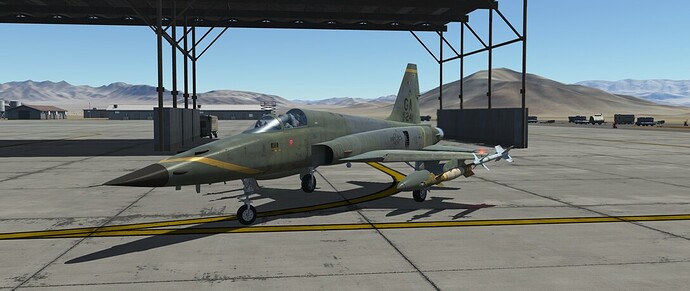Today we are going to practice LGB delivery with the F-5E. The fun thing about laser guided bombs with this aircraft is that you have to deliver the bomb the same way as a dumb bomb, using technique rather than technology. You have to work hard to get the bomb as close as possible to the target, then laser guidance adds pinpoint precision on top of it.
This Uragan Multiple Rocket Launcher is our target for today. To spice things up a bit there is a Shilka close by, ready to defend the area.
Our Forwar Air Controller overlooking the target area. He will provide the laser illumination for our attack.
Satellite view of the target area. Of note is the target elevation of 3’827 ft which will be relevant for the planing of our attack.
Our aircraft ready at the ramp at Creech AFB, armed with two GBU-12 500lb laser guided bombs. I love the fictional USAF Euro livery for the Tiger (download here USAF European Camouflage ***Fictional***).
Time to plan our attack. I select the 30°/520KTAS/7’000ft AGL medium altitude delivery profile for the Mk-82. This will allow for a safe recover above any ground threats and gives the bombs sufficient time for tracking.
Target elevation is 3’800 ft. We drop at 7’000 ft AGL, so at 10’800 ft MSL. Altitude loss for recovery will be 1’600 ft. In order to ensure a minimum safety altitude of 3’000 ft above target, abort altitude is 8’400 ft MSL. Abort altitude for fragmentation clearance is 2’000 ft which is well covered.
520 kts TAS at release altitude is 440 KIAS, which I deal in at the air speed indicator.
The delivery profile calls for a pipper depression from flight path of 176 MILS. Corrected for AOA this is 156 MILS, which I dial into the gunsight.
Now lets start up the jet and move our.
As we check out the target below, we contact the FAC over radio and arrange for laser illumination. We climb to 22’000 ft to have sufficient altitude for the delivery.
In the base leg for the attack run. To get a 30° dive angle, the target should just be visible to the side if you lean in a bit.
Roll-in.
Pull-down.
Putting the flight-path on target, then rolling out.
Pulling up for the initial pipper placement with the target about half-ways between the pipper and the aim off point. Dive angle is slightly low but ok-ish (short bomb). Initial speed is looking ok. I pull in the throttle all the way as speed will build up quickly in a 30° dive. Quick recap of error corrections: Shallow->Short, Slow->Short, Low->Long.
Picture at pipper-on-target. I decide to delay the drop a bit due to the shallow dive angle and the high altitude.
The true flight data at the very same moment (status bar at the bottom). Notice that altitude is 400 ft lower than indicated in the cockpit. Belsimtek, please fix that altimeter in the F-5E!
This is the sight picture at drop after a short delay to account for error corrections.
True flight parameters at drop. 3° shallow (slightly short bomb), 18 kts slow (short bomb), 800 ft high (long bomb). Added together this is probably a short bomb altogether. But remember, the pipper at this point is already beyond the target, so short is good.
Bombs away.
5G recovery bottoming out at 10’115 ft MSL. This is 6000 ft above target, so well above the planned safety limit.
Bombs tracking.
Thats what this laser guidance is good for after all.
That is what we like to see when pulling off the target.
Back home.

























